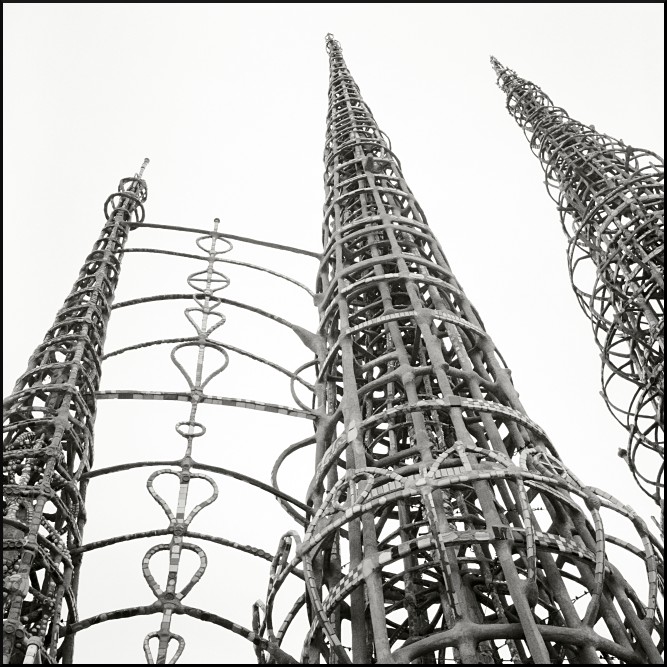vernacular my eye...
Simon Rodia began working on the Nuestra Pueblo Towers in 1921 and sustained his solitary labor on them for more than 30 years. The decades since have seen many efforts to tear them down. So far the Towers have withstood all the natural calamities that have befallen so much other Los Angeles property, including wind and fire and earthquake. They have also repelled the random depradations of vandals and delinquents. And somehow the Towers have yet managed to fend off campaigns of intentional demolition by bureacrats and developers. The Towers continue to struggle against the labels of intellectuals and art historians, though. The site became an official National Historic Landmark in 1990. The anonymous author of the National Park Service webpage describes the Towers as an example of "American Naive art". This expert pronouncement is followed by an even more curious statement: "Simon Rodia came to art in a totally spontaneous way and executed this complex sculpture over a 33-year period..." The internal contradiction suggested here is -- like -- totally marvelous, is it not? That the structure and design of the Towers was somehow a spontaneous conception, a simple naive whimsy. A monumental effort of spontaneity and naiveté spanning more than 30 years of struggle, Depression, World War, and neighborhood decay. The authors of the Wikipedia entry describe the Towers as "folk art". Like all kinds of folk are sculpting 100 foot towers in their backyards. Something akin to quilting, I suppose, or maybe painted sawblades? Sho nuf, dis be de art fo' all dem po' common folk, like whittlin' 'n' knittin' 'n' playin' da kazoo. The same article describes the Towers as an example of "vernacular architecture." Verna-whowhat? The Wikipedia entry on the topic guides us to some helpful examples of this genre: igloo, log cabin, yurt, mud hut. Vernacular my eye. Folk art my hat. We may as well describe Anna Karenina as gothic romance. Rodia had no publicist or agent. He was never paid for his work, he had no sponsor or patron. He had no "formal" education, in art or otherwise. He had no commission -- save his own inspiration: a great act of love, a passion to do "something big". Money never changed hands for this commission. Rodia gave the property and his life's work away in 1955 and never looked back. To many this seems to mean the man barely existed; he certainly could never be qualified as a "real" artist. Watts Towers isn't even recognized with the name Rodia himself christened it. And yet there it soars, Nuestra Pueblo, our village of spires, with enduring strength and grace and life, reaching into the California skies, through earthquake and riot and fire, something big, rising above all the small that surrounds it. Los Angeles, November 2006. Rolleiflex T, Fomapan 400. |
